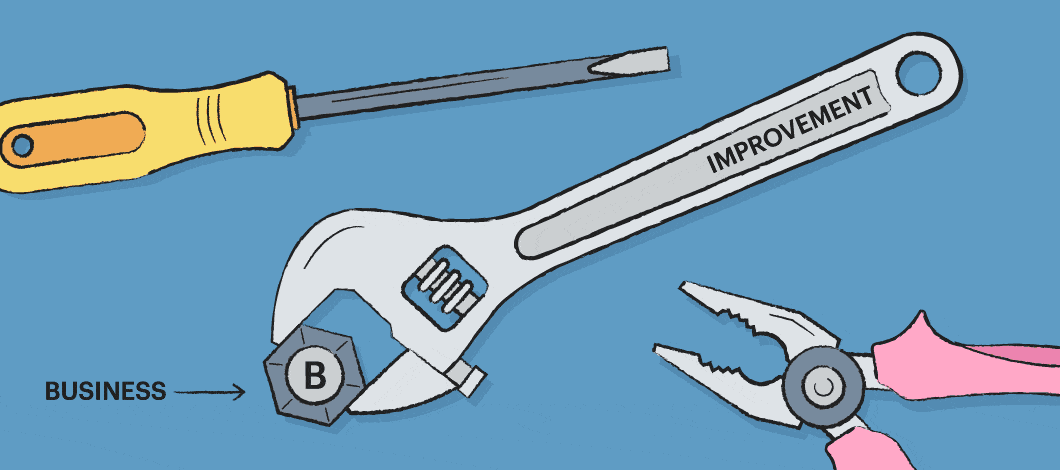A business improvement strategy shifts resources to goals with the highest potential impact. In a way, you can improve financial performance one process at a time.
We have 9 ways to optimize internal systems while enhancing customer and employee experiences.
What Is Business Process Improvement?
Business process improvement is a method used to review current systems, identify areas for improvement and prioritize them.
You can complete assessments to:
- Uncover redundancies that reduce productivity
- Discover technology usage patterns and adoption rates
- Estimate the probability of employee errors
- Ensure accountability and transparency
There are several ways to select goals, and ultimately it depends on which business process improvement methodology is used. For instance, benchmarking compares different factors of successful organizations against your own.
Other business process improvement examples include mapping systems then redesigning some while creating others from scratch.

Optimizing Operations: 9 Business Improvement Methods
The key focus areas in business operations include flexibility, costs, speed, reliability and quality. These priorities extend to internal processes, customer interactions and employee satisfaction.
Use these 9 ideas to improve your business performance.
1. Update Existing Documentation
When you’re in the weeds and working overtime to run your small business, less visible tasks get pushed to the wayside.
Outdated strategies and business documentation could put your reputation, customers and employees at risk. Get a clear view of where you stand before choosing new goals.
Start by organizing plans and policies and updating critical information. Next, get the new documents into everyone’s hands.
Check out your:
- Business plan: What’s changed since you last looked at your business plan? Fact-check the details and highlight sections requiring updates.
- Marketing strategy: Does your plan match current marketing activities? Ask your team to review it and come back with suggestions.
- Disaster recovery plan: Closing and reopening a business while maintaining customer and employee relationships is challenging. Document your steps for disaster recovery and ensure it’s accessible to core team members.
- Employee manuals: Examine handbooks and make sure they reflect current local, state, and federal laws. Update language for inclusivity and make it available online.
- Onboarding documents: What’s in your new employee packet? Evaluate required forms and update your checklist to reflect workplace changes.
- Asset and platform checklist: If your business hours change, which owned media and third-party profiles need updating? Verify that the channels and content are complete and updated.
2. Review Your Technology Stack
Many small businesses added new technologies to stay connected over the past couple of years. Some add value to your business. Others increase your overhead without significant benefits.
Take stock of the tools your team uses to get work done and decide which pandemic changes to keep.
Write down details such as:
- Brand name and type of software
- Department or individuals using it
- What platform usage accomplishes
- The software cost
- How long does it take to onboard a new employee
- Benefits or reasons why your team uses it
- Pain points or challenges with the software
Look for instances where departments use different software for similar tasks and identify pain points affecting efficiency and individual experiences.
3. Get Serious About Financial Forecasting
Measuring cash flow and making accurate assumptions are among the best ways to improve business performance.
While many accounting tools provide financial forecasting tools, they may lack what-if scenario planning features or longer-term insights.
Business mentoring organization SCORE offers a free template for projections, or you can use standalone financial forecasting software or get help from your financial planner.
4. Cut Expenses and Increase Income
The top suggestions for business improvement typically include cutting expenses while increasing revenue.
You can do this in several ways, including:
- Creating additional revenue streams
- Using smart devices to decrease energy costs
- Increasing existing customer spend or shopping frequency
- Reducing or modifying office space to account for workplace trends
- Outsourcing non-core business tasks instead of adding a full-time employee
- Negotiating with vendors for better credit terms
Source: Score
5. Evaluate Potential Skill Gaps
Many business owners fall into a pattern of setting aside training and professional development investments when they have more applications than openings.
Likewise, when you’re barely keeping your head above water, trying to cross-train an employee for a new role isn’t always ideal. However, upskilling, cross-training and professional development improve business resilience and company culture.
Employees feel valued and are less likely to quit. This trickles into better customer experiences and provides flexibility when someone misses a shift.
Identifying skills gaps also makes your business future-ready. But, the future may not be that far away.
According to technology research and consulting company Gartner, “1 in 3 skills in an average 2017 job posting in IT, finance or sales are already obsolete.” Moreover, “the total number of skills required for a single job has been increasing by 10% year-over-year since 2017.”
Department leaders should work with information technology (IT) and human resources (HR) teams to review roles and tasks.
Gartner offers recommendations for a business to improve employee skill sets, such as prioritizing training for adjacent skill sets.
But don’t forget about your skills. Online courses for business owners, mentors and coaches can also help you level up.
6. Identify Solutions for Business Process Improvement
If you followed the steps above, you now have a list of your tech tools and online platforms used across your organization. In addition, you’ve identified skill gaps that could hold back your company in the future. Now, it’s time to look at workflows.
During periods of growth, old processes get tossed out the window to make room for new technologies to suit employee demands and consumer expectations.
It can leave employees confused and open the door for mistakes. Plus, rapid and undocumented changes can introduce inefficiencies.
Check out workflows related to:
- Customer acquisition and retention
- Communication between departments
- Asset and inventory management
- Employee recruitment and retention
- Collaboration between teams
Look for opportunities to increase productivity and reduce downtime by streamlining processes.
Map the various steps required to achieve each outcome and time spent per activity. Then rate activities as value-added or non-value-added. What’s holding you back from ditching the nonvalue-added tasks?
7. Improve Business Performance Online
Simply being online doesn’t differentiate your company in a digital-first world. But you don’t have a seat at the table without an online presence.
When’s the last time you overhauled your website or updated your search engine optimization terms?
Improve your business performance by:
- Developing a customer review and referral program
- Increasing email, loyalty or text marketing sign-ups from social media
- Finding the types of content your audience values
- Creating a schedule for business page updates
- Offering employee’s assistance with creating or updating LinkedIn profiles
8. Devise a Cybersecurity Strategy
Remote work and demand for digital everything can make your company vulnerable to cyber attacks.
Security breaches hurt your reputation and decrease customer confidence and trust. Improvements help manage business risk and prevent disruptions.
A companywide cybersecurity strategy should include:
- Password manager and multifactor authentication tools for all employees
- Software user permissions based on the principle of least privilege
- Regular employee awareness campaigns
- Fraud prevention tools to protect customers
9. Encourage Creative Collaboration
Does your post-COVID office space need to change? Do your tools, manager, and culture support hybrid or fully remote workers?
Ongoing business improvements start with creativity and innovation. But if your environment isn’t supportive of how your teams communicate and collaborate, you may always be a step behind the competition.
Leaders that prioritize agility and provide flexible workspaces can get a minimum viable product (MVP) out to users within 3 months.
Digital project management tools and real-time feedback enable creative teams to act on feedback. Likewise, leaders can make critical decisions about budget and resources quicker.
Grow Your Business by Improving It
Investing in your processes and people are excellent ways to improve your business.
Focus on high-impact goals first and reassess objectives regularly.












